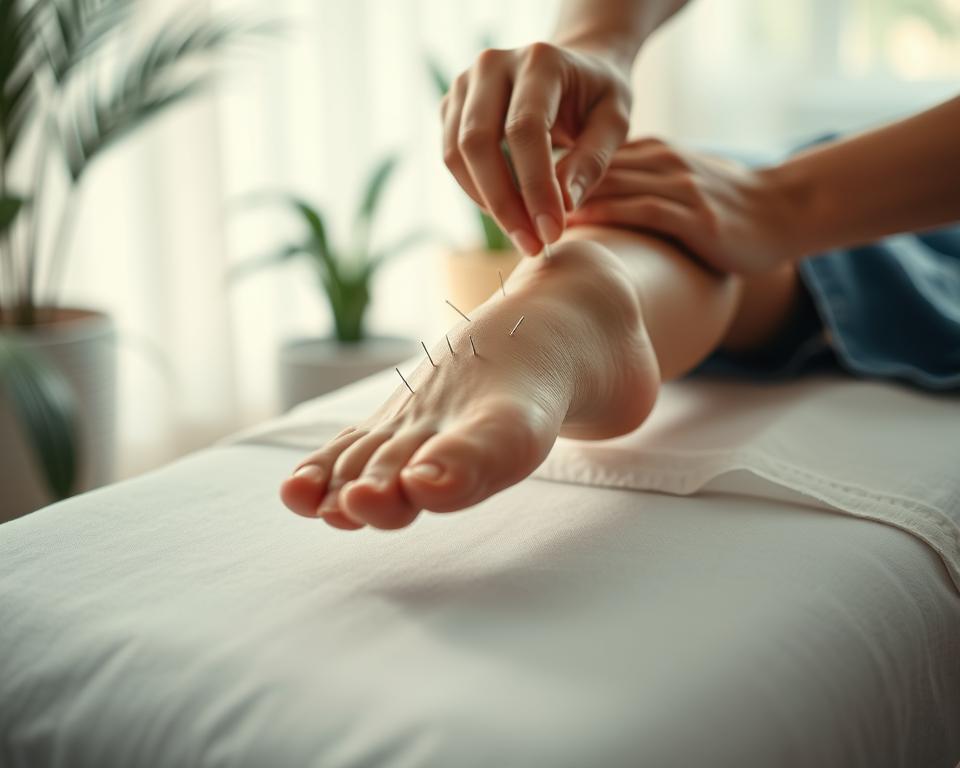
Acupressure for Blood Sugar: Natural Balancing Tips
Managing diabetes goes beyond just taking medicine. It needs a complete approach to control blood sugar well. This guide shows how acupressure, a traditional Chinese therapy, can help balance blood sugar naturally. Learn about the basics of acupressure and the key pressure points and methods to support your diabetes management at home.
We will also explore lifestyle tips and other complementary treatments to improve your health and well-being.
Read more interesting information at ::mbp-tokushima
Understanding Acupressure and Its Benefits
Acupressure is an ancient practice from traditional Chinese medicine. It helps control blood sugar and manage diabetes symptoms. This method applies gentle pressure to certain body points to heal and balance.
What is Acupressure?
Acupressure is a touch therapy that works like acupuncture but without needles. Practitioners use fingers, hands, or tools to press specific points. This helps the body’s energy flow and heal itself.
How Acupressure Can Help Regulate Blood Sugar
Acupressure targets points linked to diabetes and metabolic issues. It can balance blood sugar and ease symptoms. It boosts endorphins, improves circulation, and lowers inflammation, aiding in blood sugar control.
It also calms the mind and body, reducing stress-induced blood sugar spikes. Acupressure promotes relaxation and balance, making it a valuable tool for diabetes management.
“Acupressure is a powerful, yet gentle way to take an active role in managing your health and well-being. By tapping into the body’s natural healing mechanisms, it can provide a complementary approach to traditional diabetes treatment.”
Acupressure Points for Blood Sugar Balance
Acupressure is a traditional Chinese therapy that helps manage blood sugar levels naturally. It targets specific points on the body to regulate glucose metabolism. This can support diabetic health. Let’s look at the key acupressure points for blood sugar balance.
Vital Acupressure Points for Glycemic Control
- Spleen 6 (SP6) – This point is on the inner leg, four finger-widths above the ankle bone. It’s believed to improve insulin sensitivity and support healthy blood sugar levels.
- Liver 3 (LR3) – You can find this point on the top of the foot, between the big toe and second toe. It may help regulate blood glucose and improve liver function, which is key for glucose metabolism.
- Large Intestine 4 (LI4) – This point is on the back of the hand, between the thumb and index finger. It’s said to calm the body and may help manage stress-induced high blood sugar.
- Stomach 36 (ST36) – Located on the outer leg, three finger-widths below the kneecap. This point supports digestive health and may positively impact blood sugar regulation.
Gently applying pressure to these acupressure points may improve blood sugar control and insulin sensitivity. It may also enhance metabolic function. But, always talk to a healthcare professional before adding acupressure or any other therapy to your diabetes plan.
“Acupressure offers a natural, holistic approach to supporting healthy blood sugar levels and overall metabolic function.”
Foot Acupressure Points for Diabetes Management
Acupressure is a traditional Chinese healing practice. It offers a natural way to manage diabetes. By focusing on specific foot points, you can help your body control blood sugar levels. The Liver 3 and Spleen 6 points are especially helpful for diabetic patients.
The Liver 3 Point
The Liver 3 point is between the big toe and the second toe, just below the web space. Pressing this point gently can help the body’s energy flow smoothly. It also supports the liver in handling glucose. To use the Liver 3 point, press with your thumb or index finger for 2-3 minutes, several times a day.
The Spleen 6 Point
The Spleen 6 point is about four finger-widths above the inner ankle bone. It’s believed to help the spleen control blood sugar levels. To use the Spleen 6 point, press with your thumb or a blunt tool for 2-3 minutes, several times a day.
“Incorporating acupressure into your diabetes management routine can be a valuable complement to traditional treatments, helping to naturally maintain healthy blood sugar levels.”
Practicing acupressure on these points can help your body manage blood sugar. It might even reduce the need for medication. Always talk to a healthcare professional before adding acupressure to your diabetes plan.
Hand Acupressure Points for Glucose Regulation
The hands also have special points that can help control blood sugar levels. By using hand acupressure, you can tap into your body’s natural healing powers. This is a great way to explore alternative therapies for diabetes management.
The Large Intestine 4 (LI4) point, or “Union Valley,” is a key spot on the back of the hand. It’s between the thumb and index finger. Pressing this spot gently can help your body manage blood sugar better and improve insulin sensitivity.
- The Heart 7 (HT7) point is on the inner wrist. It’s great for acupressure for blood sugar control. Massaging it can calm your mind, reduce stress, and balance your metabolism.
- The Pericardium 6 (P6) point is on the inner forearm, just above the wrist. It’s believed to help with blood sugar levels. Stimulating this point can ease symptoms of diabetic neuropathy and improve blood flow.
Adding these pressure point therapy for glucose regulation methods to your daily routine can boost your health. Always talk to a healthcare expert for personalized advice. They can help you use acupressure safely and effectively.
Acupressure for Blood Sugar: Natural Balancing Tips
Acupressure is a great way to manage blood sugar naturally. It’s an ancient Chinese method that uses gentle pressure on the body. This helps balance energy, or qi.
Using acupressure for blood sugar control can help fix imbalances that lead to insulin resistance and high blood sugar. By pressing on certain points, you help your body heal itself. This supports holistic approaches to managing metabolic disorders.
Integrating Acupressure into Your Routine
To add acupressure for blood sugar to your routine, follow these tips:
- Do it regularly, like 10-15 minutes daily or every other day.
- Use the Liver 3 and Spleen 6 points for blood sugar control.
- Pair acupressure with other natural remedies for blood sugar control, like diet and stress management.
- See a qualified practitioner to learn how to do it safely and correctly.
Adding acupressure for blood sugar is part of a bigger health plan. By mixing it with other lifestyle changes, you can naturally balance your blood sugar.
Combining Acupressure with Lifestyle Changes
Managing blood sugar and insulin resistance is easier with a holistic approach. This combines acupressure with lifestyle changes. It’s a natural way to control blood sugar and manage diabetes.
Diet and Exercise Recommendations
Changing your diet and exercising regularly can help with blood sugar control. Eating whole, nutrient-rich foods and avoiding refined carbs and sugars boosts insulin sensitivity. A mix of cardio and strength training helps with glucose metabolism and weight control. These are key for managing type 2 diabetes.
Stress Management Techniques
Stress plays a big role in insulin resistance and metabolic disorders. Using acupressure with stress management techniques helps address insulin resistance.
“Practices like meditation, deep breathing, and mindfulness can help the body better manage cortisol levels and improve overall metabolic function.”
Adding these stress-relieving methods to your daily routine boosts acupressure’s benefits for blood sugar balance.

By using acupressure and a holistic lifestyle, you can naturally manage blood sugar. This reduces diabetes complications and improves metabolic health.
Traditional Chinese Medicine and Blood Sugar Control
Traditional Chinese medicine (TCM) offers a unique way to manage blood sugar levels and diabetes. At its core, TCM focuses on Qi, the vital life force in our bodies. It believes that keeping Qi balanced, along with yin and yang energies, is key to health.
TCM sees diabetes as an imbalance in Qi and a disruption of yin and yang harmony. This view guides the use of traditional Chinese medicine for hyperglycemia and other metabolic issues. Practitioners use acupressure, herbal remedies, and dietary changes to help balance and regulate blood sugar.
| TCM Principles | Application for Blood Sugar Control |
|---|---|
| Qi (Life Force) | Promoting the smooth flow of Qi to support overall bodily functions, including glucose metabolism |
| Yin-Yang Balance | Maintaining the delicate equilibrium between opposing yet complementary forces to prevent metabolic imbalances |
| Holistic Approach | Addressing the root causes of blood sugar dysregulation through a combination of eastern techniques for metabolic disorders and lifestyle interventions |
By using traditional Chinese medicine for hyperglycemia and other complementary treatments for type 2 diabetes, people can find a holistic way to manage their blood sugar and metabolic health.
“In Traditional Chinese Medicine, the root cause of diabetes is often seen as an imbalance in the body’s Qi and the disruption of the delicate harmony between yin and yang.”
Mixing TCM principles with modern medicine can offer a helpful approach to managing blood sugar and improving overall health.
Precautions and Safety Considerations
Using acupressure for blood sugar management requires some caution. Acupressure is seen as safe and non-invasive. Yet, there are key things to remember.
When to Consult a Professional
If you have health issues, especially with diabetes management or type 2 diabetes, talk to a doctor first. They can help choose the right acupressure points and methods for you. This ensures it’s safe and works well as a complementary treatment.
Also, if you’re on meds for blood sugar control or other health problems, check with your doctor. They can tell you about any possible issues or things to avoid.
People with severe neuropathy, open wounds, or bleeding disorders should be careful. They might need special care and changes in acupressure techniques to stay safe.
Working with a skilled acupuncturist or traditional Chinese medicine (TCM) practitioner is best. They can tailor acupressure for you and watch how it goes. This way, you can safely add it to your diabetes management plan.
Acupuncture for Diabetic Neuropathy
Acupressure is a natural way to manage blood sugar. Acupuncture also helps with diabetic neuropathy, a common diabetes complication. This condition causes nerve damage and chronic pain, affecting those with diabetes a lot.
Acupuncture is a key part of Traditional Chinese Medicine. It aims to help with diabetic neuropathy symptoms. Practitioners use specific body points to help the body heal itself.
Studies show acupuncture can be a good treatment for diabetic neuropathy. A review of over 20 trials found it better than fake acupuncture. It helped reduce pain and improve nerve function in people with diabetes.
“Acupuncture has the potential to be a safe and effective option for managing the painful symptoms of diabetic neuropathy, offering an alternative to pharmaceutical interventions.”
How acupuncture works is still being studied. But, it might release natural pain-relievers and change how the body feels pain.
Adding acupuncture to a diabetes management plan can be helpful. It can be part of a bigger plan to tackle diabetic neuropathy and improve health.

It’s key to see a skilled acupuncture practitioner for diabetic neuropathy. They can create a treatment plan and check progress. This ensures acupuncture is used safely and effectively in managing diabetes and its complications.
Eastern Techniques for Metabolic Disorders
Eastern medical traditions offer a holistic approach to managing metabolic disorders like diabetes and insulin resistance. They use the wisdom of Ayurveda and traditional Chinese medicine. This helps us understand the body’s systems better and find balance.
Holistic Approaches to Insulin Resistance
Insulin resistance is more than just blood sugar issues. Eastern practitioners focus on the whole person, not just symptoms. They use acupressure, herbal remedies, and mindfulness practices to restore balance and resilience.
- Acupressure: Applying gentle pressure to specific points on the body can help stimulate the flow of energy and promote insulin sensitivity.
- Herbal Remedies: Certain herbs and spices, such as cinnamon, berberine, and bitter melon, have been shown to improve insulin function and glucose metabolism.
- Mindfulness Practices: Incorporating stress-reducing techniques like yoga, meditation, and deep breathing can help manage the psychological factors that contribute to insulin resistance.
This holistic approach helps individuals with metabolic disorders find natural solutions. It addresses the root causes for long-term well-being.
“The essence of traditional Chinese medicine is to treat the person, not just the disease.”
| Eastern Technique | Benefits for Metabolic Disorders |
|---|---|
| Acupressure | Stimulates energy flow, promotes insulin sensitivity |
| Herbal Remedies | Improve insulin function, regulate glucose metabolism |
| Mindfulness Practices | Manage stress, support overall well-being |
Complementary Treatments for Type 2 Diabetes
People with type 2 diabetes can find relief with various complementary and alternative therapies. These natural methods can work alongside traditional treatments. They offer a holistic way to manage health.
Herbal remedies are one such treatment. Herbs like cinnamon, bitter melon, and fenugreek can help control blood sugar and improve insulin sensitivity. They shouldn’t replace prescribed medicines but can be a helpful addition.
Mind-body practices, such as yoga and meditation, are also beneficial. They help manage stress and improve mood. These practices can also help regulate blood sugar levels.
Nutritional supplements, like chromium and magnesium, are being studied for their benefits. They may support healthy blood sugar levels. However, it’s important to use them responsibly and with a healthcare professional’s guidance.
Managing type 2 diabetes often requires a mix of traditional and natural treatments. Exploring these options can empower individuals to take charge of their health. It can lead to better blood sugar control and overall well-being.
Natural Remedies for Blood Sugar Control
Many people are now using natural remedies to help control their blood sugar. These plant-based solutions aim to support metabolic health. They might also help ease symptoms of high blood sugar.
Herbs and Supplements for Hyperglycemia
Some herbs and supplements have shown promise in managing blood sugar. Cinnamon, for example, can make insulin work better and lower blood sugar levels. Berberine, found in plants like goldenseal, has also been studied for its diabetes-fighting properties.
Other natural options include bitter melon, fenugreek, ginger, and chromium. They help in different ways, like improving insulin action and reducing sugar absorption. Always talk to a doctor before adding these to your treatment plan.


